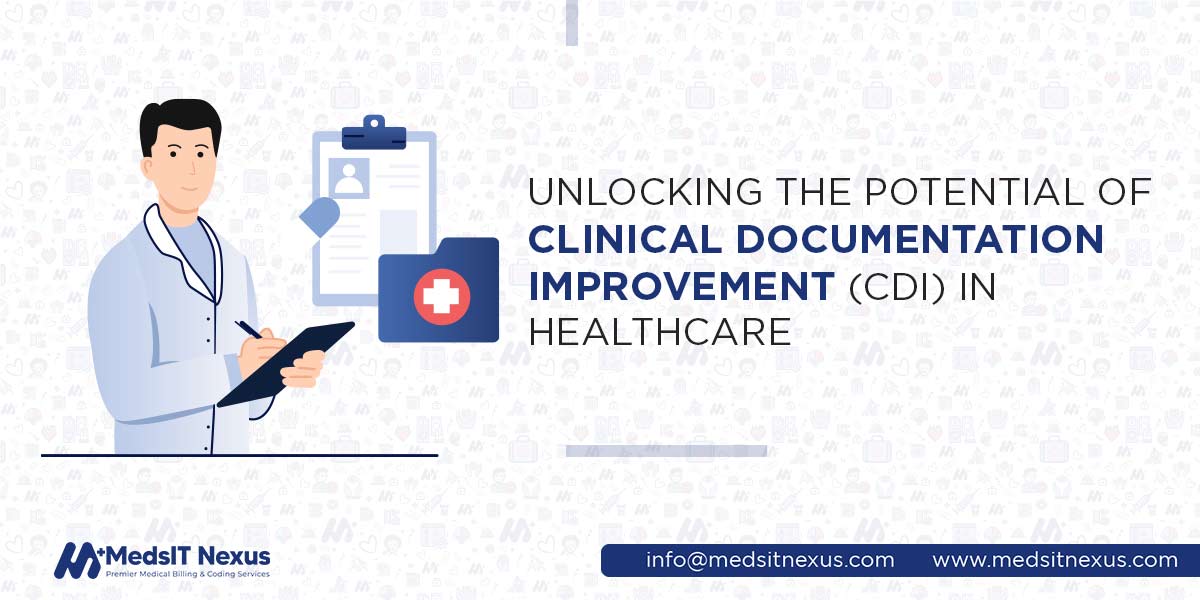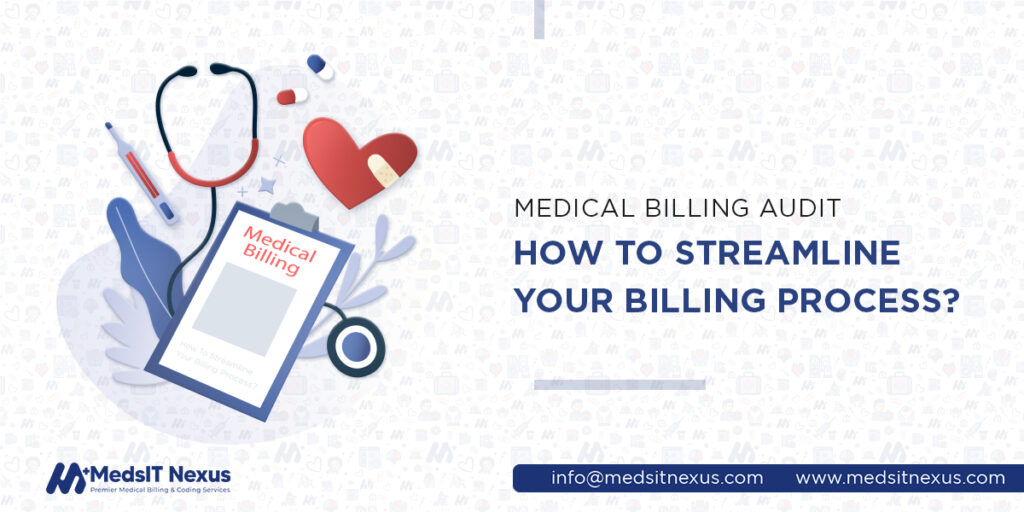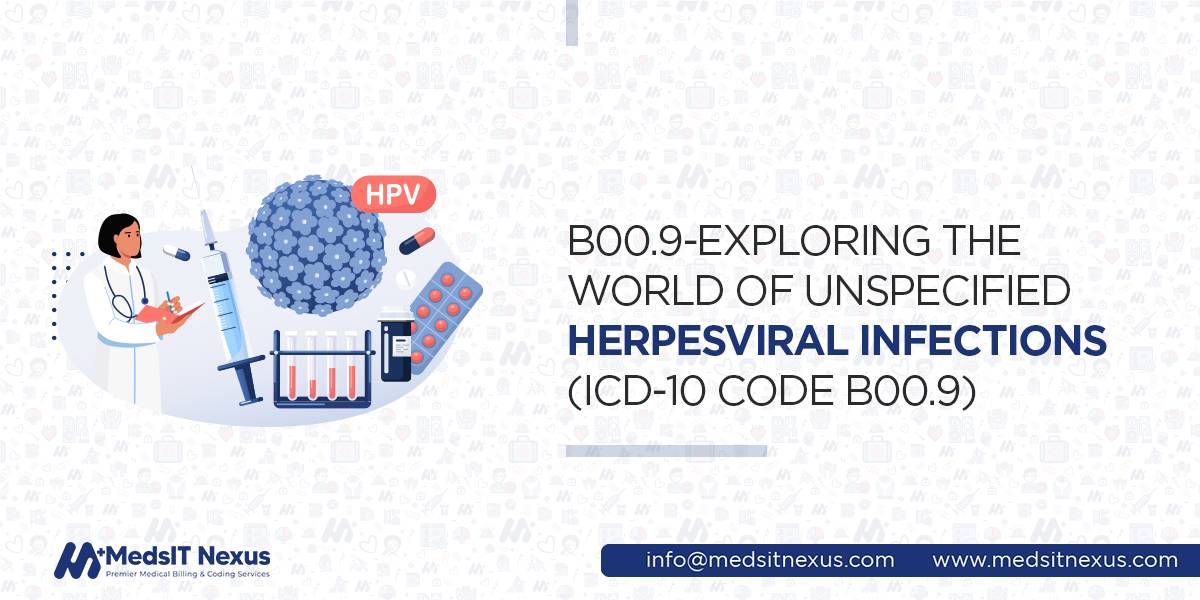Unlocking the Potential of Clinical Documentation Improvement (CDI) in Healthcare

The ultimate goal of health institutions is to ensure preventive patient care and eliminate injury and illness; Clinical Documentation Improvement (CDI) also comes with the same objective. Healthcare professionals keep advancing their practice to fulfill the purpose, and educating providers and coders on reliable documentation skills is paramount because no need remains for queries and audits. Moreover, employing novel technology has reshaped various activities and proven practice efficiency. According to Ewoterai et al. Electronic Medical Records EMR, data standards, computer-assisted programs, cross-platform communication, and documentation suggestions for clinicians with automatic links to the appropriate codes can eliminate the need for CDI specialists and practice queries in the future.
However, accurate and complete clinical information of patients visiting hospitals is critical in improving healthcare practice. Providers must ensure an understanding of the severity of the patient's condition and correctly record it in the documentation so that quality care can be provided. By enhancing the quality of clinical documentation, CDI specialists can serve the healthcare system with better patient care and healthcare data integrity and, importantly, encounter the challenge of maintaining quality revenue for the services offered. Moreover, accurate and concise health records of patients support the entire system because accurate data supports analytics, research, and population health management. In this guide, I will cover adequately the details of the significant role that CDI has in healthcare and in optimizing patient care data efficiently.
Clinical Documentation Improvement (CDI) - History and Purpose
CDI ensures the completeness and accuracy of clinical information about a patient's medical condition. The process encompases reviewing the disease process, diagnosis findings, and the features the provider may have missed while documenting. CDI is conducted by CDI specialists who have a good knowledge and background in both medical coding accuracy and clinical function.
Globally, Clinical Documentation Improvement or Mid-revenue Cycle Management is a market unto itself and the fastest expanding sector in healthcare. Research conducted internationally on Mid-Revenue Cycle Management or Clinical Documentation Improvement CDI Market for the period from 2023 to 2030 reports:
The Global Mid-Revenue Cycle Management or Clinical Documentation Improvement CDI market is anticipated to rise considerably during the forecast period between 2023 and 2030. The market is growing steadily in 2023, with critical players adopting rising strategies and methods. The market will increase over the projected horizon.
The process is designed to be implemented to achieve accurate and thorough documentation of medical records.
Before the invention of the phrase, CDI programs were an integral part of healthcare. The Centres for Medicare & Medicaid Services (CMS) introduced the Medicare Severity Diagnosis Related Groups (MS-DRGs), which gave them a rise in popularity around 2007.
Why is Clinical Documentation Improvement Essential in Healthcare?
In one interview, Vananzio Arquilla, the managing director of Claro Healthcare, responded to the benefits of implementing CDI well in healthcare practice. He answered that coding rules vary in any setting, whether inpatient, outpatient, or physician billing, so the coder must be specific about those variations in each set. He further ensured that the more specific the physicians become, the more anticipated reimbursement is generated across the healthcare system and the services provided. In contrast, an incomplete patient record likely lessens the rates of revenue and poor quality care results.
CDI can improve medical billing and coding and the accuracy of clinical documentation, which likely results in more reimbursement. However, incorrect claim submission resulting from poor documentation leads organizations to unfavorable audits. These require professionals to pay fines or return payments improperly collected from payers. As a result, the proper implementation of CDI in claim processing helps authorities optimize revenue accuracy on the one hand and prevent the practice of these expenses on the other.
Among all these, hospitals and healthcare authorities are aware of certain audits and penalties as a consequence of error. CDI specialists have the responsibility of evaluating practice and filling the gaps. They must understand and have complete knowledge of the federal regulations regarding fraud and abuse, compliance policy, and payer requirements regarding patient disease representation.
What happens if clinical practice documents incorrect patient information?
An OIG audit published in July 2020 found that hospitals overbilled Medicare by $1 billion by incorrectly assigning severe malnutrition diagnosis codes to inpatient hospital claims. This is one example of poor documentation practices in healthcare facilities—and documentation that does not support coding. 164 of the 200 claims examined in this audit had severe malnutrition diagnosis codes when they ought to have had other types of malnutrition or none. Wherever possible, OIG advised Medicare to recover the overpayments from the providers. By evaluating the evidence and instructing physicians and coders on the documentation necessary to support malnutrition diagnosis and codes, a CDI professional may assist in preventing this kind of inappropriate reporting and confirming that patients have accurate diagnoses in the medical record.
Clinical Documentation Improvement (CDI) Enhances Patient Record Quality
Diagnosing patient problems and providing appropriate care is the core objective clinicians encounter running the practice. Clinical documentation is a whole language unto itself. They have to speak rightly and in the right way, as it influences how others interpret the information. Network administration, healthcare providers, patients, and care pathway navigators are those others who proceed with the language to provide further consideration. Improving CDI means facilitating patients with the care they need and consequently bringing positive outcomes for the practice. The more smooth the communication with patients, the less likely they are to fall through the cracks.
Proper Reimbursement with Proper CDI
Regardless of industry size or organization, every organization needs substantial revenue, and implementing the proper CDI is the key to owning it. Similarly, correct clinical documentation leads to accurate coding and reimbursement by the service payers.
According to Dr. David Schillinger, Chief Medical Officer for SCP, ninety-five percent of ensuring appropriate reimbursement is just good documentation practices. The other five percent consists of learning the rules of proper documentation and obtaining adequate reimbursement.
Improved Revenue Cycle Management
Proper implementation of CDI programs in healthcare has a positive financial impact on the healthcare industry. If healthcare providers ensure the appropriate documentation with clear and concise information, practitioners optimize coding and billing for revenue. Comprehensive documentation ensures that the severity and sensitivity of patient conditions are transparently represented so the insurance providers improve the reimbursement and reduce the risk of claim denials.
Successful CDI Requires Collaboration and Education
Collaboration and training is an effective strategy for businesses. CDI requires various stockholders' collaboration, including physicians, nurses, doctors, coders, clinical documentation specialists, and HIM professionals. Healthcare authorities must ensure that conducting multiple training and education programs helps enhance the practitioners' knowledge and skills of proper clinical documentation. Moreover, they must keep up-to-date on the latest coding policies and modifications, documentation requirements, and industry best practices.
The role of technology in CDI
Technology today is critical in assisting CDI efforts because of the digital age. Clinical documentation improvement software, computer-assisted coding (CAC), natural language processing (NLP), electronic health records (EHRs), and CAC are effective methods for streamlining CDI workflows, enabling correct coding, and data abstraction. Utilizing technological solutions can significantly improve CDI efficacy and efficiency. The importance of Clinical Documentation Improvement (CDI) professionals will likely increase rather than decrease in the ChatGPT age. According to Monica Watson, Senior Director at the University of Arkansas for Medical Sciences (UAMS), "our role in ensuring that clinical indicators specific to the patient's episode of care, such as appropriate monitoring, evaluation, assessment, and treatment are meticulously documented becomes even more vital in the era of generative AI and hallucinations." Utilizing the AI revolution, hospitals like the University of Arkansas for Medical Sciences can identify, on average, $800K per 100 beds in net new revenue, all backed by clinical indicators.
Ways for Successful Clinical Documentation Improvement (CDI)
MedsIT Nexus offers your clinical practice the best ways to overcome documentation challenges, whether your practice wants to improve documentation or needs help with compliance.
Training and Education
- Ongoing training and education for healthcare providers
- Focus on accurate and complete clinical documentation
- Covers proper coding, terminology, and compliance
Use of Electronic Health Records (EHRs)
- Integrate EHR systems for streamlined documentation
- Reduce errors compared to paper records
- EHRs can offer documentation prompts and reminders
Clinical Decision Support (DCS) Tools
- Integrate CDS tools into EHR systems
- Aid healthcare providers in accurate diagnosis and treatment decisions
- Contributes to improved documentation quality
Standardized Templates and Checklists
- Develop standardized documentation templates and checklists
- Ensure consistent capture of critical patient data
- Facilitates comprehensive documentation
Regular Audits and Feedback
- Conduct routine audits of clinical documentation
- Identify areas for improvement
- Provide feedback to encourage ongoing enhancement and adherence to best practices.
Advance Your Clinical Documentation Efforts with MedsIT Nexus Medical Coding and Billing Services
Clinical documentation improvement (CDI) plays a crucial role in healthcare but can be challenging. Connect with us and explore how MedsIT Nexus medical billing and coding services can add to your successful practice. We employ measurable ways to improve your clinical documentation by adding our transcriptionists to your team. Our team of expert coders comprehends patterns of market movements to strategize clinical documentation improvement. Moreover, we understand the technological shift in the healthcare industry and integrate several methods to automate your practice efficiently.
Dr. Sana Pervez, Pharm.D, CCS, CPC -
Clinical Compliance Advisor at MedsIT Nexus
Responsible for Medical and compliance review of all healthcare RCM and billing content before publication.






